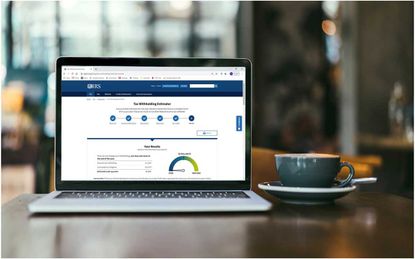
Knowing how the IRS Form W-4 form works can help with new jobs, tax refunds, and avoiding estimated tax payments.
When you purchase through links on our site, we may earn an affiliate commission. Here’s how it works.

When you start a new job, your employer will ask you to complete a W-4 form. This form requires you to provide information such as your expected filing status, family income from other jobs, number of dependents, and tax deductions you plan to claim. The IRS W-4 helps determine the correct amount of income tax your employer will withhold from your wages.
You can also use the W-4 if you have a side hustle and want to avoid estimated tax payments or if you receive any other non-wage income throughout the year. Additionally, you can use the W-4 form to adjust your tax refund for the following year.
So, it is important to fill out the W-4 form correctly. To help, here are ten things you need to know.

You are not required to file a W-4 form with your employer each year. If you are happy with your current tax withholding, you can leave your current Form W-4 in effect with your employer.
Ideally, you want your annual withholding and tax liability for the year to be close so that you don't owe a lot or get back a lot when you file your return. (Remember, a large tax refund means you gave the IRS an interest-free loan.)
If your tax withholding is off track, submitting a new W-4 can help. That is especially important if you have a significant change in your life, such as getting married, having a child, or buying a home.

The W-4 form can be relatively easy if you only have one job, and your taxes are simple. (Simple means you are not filing a joint return with a spouse who works, you don't have dependents, you're not itemizing or claiming deductions other than the standard deduction, you're not claiming tax credits, and you don't have non-employment income.)
If all those are true, you only have to provide your name, address, Social Security number, and filing status, and then sign and date the W-4 form. Your employer will compute your tax withholding based on the standard deduction and income tax rates for your filing status, with no other adjustments.

If your taxes are more complicated, it will probably take you more time to complete a W-4 form.
For example, when new hires fill out a W-4 form, they may need to look up information from their last tax return to get Information about total deductions from the previous tax year, the child tax credit, and how much non-wage income they reported.
 Multiple jobs and working spouses require more information" width="" />
Multiple jobs and working spouses require more information" width="" />
Having multiple jobs or a working spouse can affect the tax withheld from your wages.

The W-4 form allows you to adjust your withholding to account for certain tax credits and deductions. There are lines on the W-4 form to add these amounts. Including tax deductions and credits on the form will decrease the amount of tax withheld, increase the amount of your paycheck, and reduce any refund you may get when you file your tax return.
Workers can factor in the child tax credit and the credit for other dependents in Step 3 of the form. You can also include estimates for other tax credits, such as education credits or foreign tax credits.
For deductions, it's important to note that you should only enter deductions other than the basic standard deduction on Line 4(b). So, you can include itemized deductions on this line. If you take the standard deduction, you can also include other deductions, such as those for student loan interest and IRAs.
If you have multiple jobs or a working spouse, complete Step 3 and Line 4(b) on only one W-4 form. It should be the form for the highest-paying job to get the most accurate withholding.

To get the most accurate withholding, use the IRS's Tax Withholding Estimator to help you fill out the W-4 form. You will also want to use this tool if you expect to work only part of the year, have dividend income or capital gains subject to additional taxes (e.g., the additional Medicare tax), or have self-employment income.
You will want a few things by your side before you start using the tool — you'll need them as a source of information.
For example, have your most recent federal income tax return handy. You will also need your most recent pay stub (your spouse's, too, if you're married). Collect information for other sources of income as well, such as invoices, statements, and 1099 forms.

If you receive taxable income that isn't from wages, like interest, dividends, or distributions from a traditional IRA, you can have your employer withhold tax from your paycheck to cover the extra taxes. Just put the estimated total amount of this income for the year on Line 4(a) of your W-4 form, and your employer will calculate the proper withholding amount for each pay period.
Don't include income from a side gig on Line 4(a). Keep reading for information on how to get your boss to withhold taxes from your regular paycheck for self-employment income.

Suppose you have a side job as an independent contractor (i.e., not an "employee"). In that case, you can use the W-4 form to have extra taxes withheld from your regular job's paycheck to cover your side job, too (Instead of making estimated tax payments for your second job.)

You can claim an exemption from withholding on a W-4 form. There isn't a particular line for this on the form, but you can claim an exemption by writing "Exempt" in the space below Line 4(c) if you qualify. You must also provide your name, address, Social Security number, and signature.
Looking ahead to next year, you qualify for an exemption in 2024 if (1) you had no federal income tax liability in 2023 and (2) you expect no federal income tax liability in 2024. (If your total expected income for next year is less than the standard deduction amount for your filing status, then you satisfy the second requirement.)
Note: If you claim an exemption, you will not have income tax withheld from your paycheck, and you may owe taxes when you file your return. You might be hit with an underpayment penalty. However, an exemption is also good for only one year, so you must reclaim it yearly.

You can adjust your W-4 form to generate a larger tax refund (or refund in general) if you wish. Although the tax withholding system aims to produce the most accurate withholding, you can add an extra amount on Line 4(c) for "extra withholding" to increase your income tax withholding and reduce your paycheck. That will either increase your tax refund or decrease any tax you owe when you file your tax return.
If you have a specific refund amount, let the IRS's Tax Withholding Estimator tell you how much to put down on Line 4(c). You can even download a W-4 form with the appropriate amount preloaded on Line 4(c).